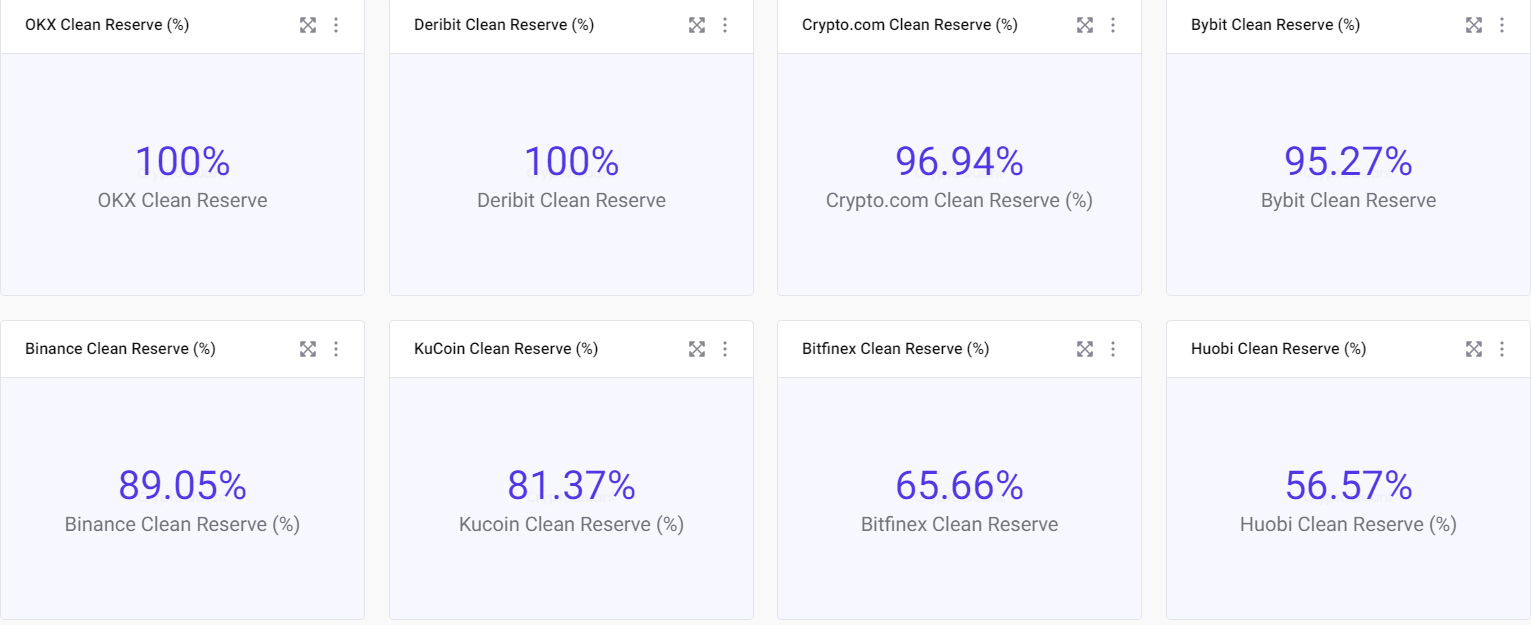First Mover Asia: Missing From the Debate About Binance’s Proof of Reserves and Auditor, One Metric Shows Another Exchange Could Be in Trouble.

Good morning. Here’s what’s happening:
Prices: Bitcoin was flat heading into Asia hours on Monday, though crypto analysts are warning that pressure from the Federal Reserve’s monetary tightening isn’t likely to fade anytime soon.
Insights: Proof of reserves isn’t necessarily the best way to check a company’s health.
Catch the latest episodes of CoinDesk TV for insightful interviews with crypto industry leaders and analysis. And sign up for First Mover,our daily newsletter putting the latest moves in crypto markets in context.
Prices
CoinDesk Market Index (CMI)
$826
−1.0 ▼ 0.1%
Bitcoin (BTC)
$16,781
+30.9 ▲ 0.2%
Ethereum (ETH)
$1,189
+3.4 ▲ 0.3%
S&P 500 futures
3,883.75
+12.3 ▲ 0.3%
FTSE 100
7,332.10
−94.1 ▼ 1.3%
Treasury Yield 10 Years
3.48%
▲ 0.0
BTC/ETH prices per CoinDesk Indices, as of 7 a.m. ET (11 a.m. UTC)
Fed’s Powell replaces SBF as crypto-markets bogeyman
By Bradley Keoun
Now that the most tumultuous phase of the aftermath of the swift collapse of Sam Bankman-Fried’s FTX exchange has passed, crypto traders are back to dealing with a familiar adversary: the Federal Reserve.
The U.S. central bank’s campaign this year to squelch soaring inflation by tightening monetary conditions is again becoming top-of-mind for crypto traders, with Fed Chair Jerome Powell and top officials signaling last week that the stiff pressure might remain well into 2023.
“While volatility-crushing fatigue has set in as the Christmas/New year interval approaches, markets will no doubt have to react to this in a bearish way, either with a slow bleed into year-end, or with another January/Q1 sell-off like we saw this year,” the crypto trading firm QCP Capital wrote in a Dec. 17 note on Telegram.
Crypto markets were sedate over the weekend and staying flat into Asia trading hours early Monday, with the CoinDesk Market Index (CMI) unchanged over the past 24 hours. Bitcoin (BTC), the largest cryptocurrency, was changing trading hands around 16,760, up 0.18% over 24 hours.
According to Greg Cipolaro, global head of research at the bitcoin-focused investment firm NYDIG, investors remain “understandably skittish about the practices of exchanges, prop trading firms and lenders” given the industry events of the past six to nine months.
The ongoing pressure from the Fed might “keep a lid on financial assets, including bitcoin, until we get some relief from the monetary policy backdrop,” he wrote in a Dec. 16 newsletter.
Glassnode, the data and analysis firm, noted that “supply and demand dynamics show a lack of activity as investors remain wary following the demise of FTX and the FUD around Binance,” the world’s largest crypto exchange. “FUD” is an acronym for “fear, uncertainty and doubt,” and in the crypto lexicon it refers to pretty much any fresh information that tends toward the bearish side.
“The outlook for bitcoin is not assured for the year-end given the great resistance above $18K, despite the continued seller exhaustion,” according to Glassnode.
Insights
Proof of Reserves is useless without proof of liabilities
By Sam Reynolds
Mazars, the auditing firm working with Binance and other crypto exchanges on proof-of-reserves statements, is pausing its crypto work for the right reason: It’s not producing audits, as has been erroneously claimed. But for now, on-chain data is an excellent guide to see who’s really in trouble.
Mazars announced Friday that it’s pausing work for crypto clients because what it’s producing is being misunderstood by the public. Almost immediately, the market panicked, pushing down Binance’s BNB token by almost 10%. It’s since recovered 4.6% over the last 24 hours, according to CoinDesk data.
Mazars is right for doing this. We shouldn’t be calling these reports audits, because they don’t contain a key element for any financial report — liabilities. But we shouldn’t be panicking either, because on-chain data is so far supporting the reported data from Mazars.
There’s a far more interesting metric that we can retrieve via on-chain data that wouldn’t be captured in a Mazars report, which is quality of reserves. And this metric, which measures how reliant an exchange’s reserves are on its proprietary token, shows that Binance doesn’t have the issue some think it does.
Data from CryptoQuant, which pioneered the metric in a recent report, shows that Binance’s reserves are 89% clean.

(CryptoQuant)
In contrast, Huobi’s reserves of roughly $3 billion are 56.7% ‘clean’, or to put it another way, 43.3% of its reserves are made up of its own exchange token. It’s where our attention should be focused now, and not Binance, given that the exchange is the sixth biggest and does around $422 million in daily volume per CoinGecko data.
To be sure, Binance is sometimes its own worst enemy and tends to add fuel to its own fire and encourage conspiracy theories and market panic. Binance is not doing much to help itself by temporarily suspending USDC withdrawals (other stablecoins remained open) and being coy when asked where its controlling company is.
All this comes as Huobi introduces a new burning mechanism to burn more of its token (think: buyback), thus increasing its value. Huobi’s HT token is down nearly 40% on-year, and it’s now priced at $XX, according to CoinGecko data. In a recent press release, Huobi said there was a 15.94% increase in the number of HT burnt in November compared to October, and this will increase more in the first quarter of 2023.
“Huobi reserves have a highly risky setup at the moment,” Caue Oliveria, one of CryptoQuant’s author-analysts, wrote in a note to CoinDesk. “Tokens issued by the company itself are a risk to the company’s net health, since it is difficult to sustain the veracity of the issuance of these coins.”
Oliveria reiterated that FTX’s use of FTT to collateralize loans was one of its causes of failure, and Huobi is playing a dangerous game here.
But CoinGecko’s Bobby Ong, its co-founder, and COO, take on the situation is more restrained. He told CoinDesk that we also need to know Huobi’s liabilities to get a proper sense of the situation.
“If the exchange is not using its collateral to borrow money, it doesn’t really matter what the clean reserves are. If every customer’s crypto is fully held 1:1 in proper wallets, it doesn’t really matter,” he told CoinDesk via Telegram. “What is more important, is knowing the exchange’s liabilities amount. Knowing the reserves is one part of the equation, but more importantly, what are the liabilities.”
And those liabilities, for now, are a mystery. Huobi would not respond to emails asking for comment on CryptoQuant’s number or its liabilities by press time. While Huobi has posted its proof of reserves, missing from this report, and many other exchange’s similar reports, are its proof of liabilities (hence why Mazars wants out of this business).
“If an exchange has $1 billion in bitcoin liability, it better have $1 billion of bitcoin in cold wallet reserves backing this liability,” Ong concluded.






 Bitcoin
Bitcoin  Ethereum
Ethereum  Tether
Tether  USDC
USDC  TRON
TRON  Dogecoin
Dogecoin  Cardano
Cardano  Bitcoin Cash
Bitcoin Cash  Chainlink
Chainlink  LEO Token
LEO Token  Stellar
Stellar  Monero
Monero  Litecoin
Litecoin  Zcash
Zcash  Hedera
Hedera  Dai
Dai  Cronos
Cronos  OKB
OKB  Tether Gold
Tether Gold  Ethereum Classic
Ethereum Classic  KuCoin
KuCoin  Gate
Gate  Algorand
Algorand  VeChain
VeChain  Cosmos Hub
Cosmos Hub  Dash
Dash  Stacks
Stacks  Tezos
Tezos  TrueUSD
TrueUSD  IOTA
IOTA  Basic Attention
Basic Attention  Decred
Decred  Theta Network
Theta Network  NEO
NEO  Synthetix
Synthetix  Qtum
Qtum  Ravencoin
Ravencoin  0x Protocol
0x Protocol  DigiByte
DigiByte  Nano
Nano  Zilliqa
Zilliqa  Siacoin
Siacoin  Holo
Holo  Numeraire
Numeraire  Waves
Waves  Ontology
Ontology  Enjin Coin
Enjin Coin  Status
Status  Pax Dollar
Pax Dollar  BUSD
BUSD  Hive
Hive  Lisk
Lisk  Steem
Steem  Huobi
Huobi  NEM
NEM  OMG Network
OMG Network  Augur
Augur  Bitcoin Gold
Bitcoin Gold  Ren
Ren  HUSD
HUSD